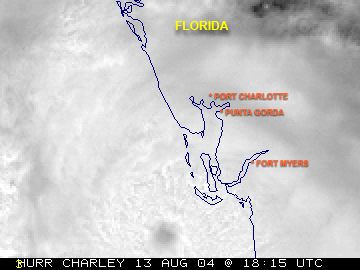
Landfall (meteorology)
Encyclopedia

Tropical cyclone
A tropical cyclone is a storm system characterized by a large low-pressure center and numerous thunderstorms that produce strong winds and heavy rain. Tropical cyclones strengthen when water evaporated from the ocean is released as the saturated air rises, resulting in condensation of water vapor...
(also known as a hurricane) or a waterspout
Waterspout
A waterspout is an intense columnar vortex that occurs over a body of water and is connected to a cumuliform cloud. In the common form, it is a non-supercell tornado over water. While it is often weaker than most of its land counterparts, stronger versions spawned by mesocyclones do occur...
coming onto land after being over water. When a waterspout
Waterspout
A waterspout is an intense columnar vortex that occurs over a body of water and is connected to a cumuliform cloud. In the common form, it is a non-supercell tornado over water. While it is often weaker than most of its land counterparts, stronger versions spawned by mesocyclones do occur...
makes landfall it is reclassified as a tornado, which can then cause damage inland. When a fair weather waterspout makes landfall it quickly dissipates as it loses the inflow of warm air into the vortex.
Tropical cyclone
A tropical cyclone is classified as making landfall when the center of the storm moves across the coast; in strong tropical cyclones this is when the eyeEye (cyclone)
The eye is a region of mostly calm weather found at the center of strong tropical cyclones. The eye of a storm is a roughly circular area and typically 30–65 km in diameter. It is surrounded by the eyewall, a ring of towering thunderstorms where the second most severe weather of a cyclone...
moves over land. This is where most of the damage occurs within a mature tropical cyclone, such as a typhoon or hurricane, as most of the damaging aspects of these systems is concentrated near the eyewall. Such effects include the peaking of the storm surge
Storm surge
A storm surge is an offshore rise of water associated with a low pressure weather system, typically tropical cyclones and strong extratropical cyclones. Storm surges are caused primarily by high winds pushing on the ocean's surface. The wind causes the water to pile up higher than the ordinary sea...
, the core of strong winds comes on shore, and heavy flooding rains. These coupled with high surf can cause major beach erosion
Erosion
Erosion is when materials are removed from the surface and changed into something else. It only works by hydraulic actions and transport of solids in the natural environment, and leads to the deposition of these materials elsewhere...
. In low lying areas, the storm surge can stay inland for a long time and mix with chemicals already in the area to create a toxic mess. When a tropical cyclone makes landfall, the eye closes in upon itself due to the weakening process, which causes surf to decrease. Maximum sustained wind
Maximum sustained wind
The maximum sustained winds associated with a tropical cyclone are a common indicator of the intensity of the storm. Within a mature tropical cyclone, they are found within the eyewall at a distance defined as the radius of maximum wind, or RMW. Unlike gusts, the value of these winds are...
s will naturally decrease as the cyclone moves inland due to frictional differences between water and land with the free atmosphere.
Landfall is distinct from a direct hit. A direct hit is where the core of high winds (or eyewall) comes onshore but the center of the storm may stay offshore. The effects of this are quite similar to a landfall, as this term is used when the radius of maximum wind within a tropical cyclone moves ashore. These effects are; high surf, heavy rains that may cause flooding, water build up along the coast with minor storm surge, coastal beach erosion, high winds, and possibly severe weather.
Tornado or waterspout
When a tornadic waterspoutWaterspout
A waterspout is an intense columnar vortex that occurs over a body of water and is connected to a cumuliform cloud. In the common form, it is a non-supercell tornado over water. While it is often weaker than most of its land counterparts, stronger versions spawned by mesocyclones do occur...
makes landfall it is reclassified as a tornado, which can subsequently cause damage to areas inland of the coast. When a fair weather waterspout makes landfall it quickly dissipates due to friction which reduces the amount of warm air supplied to the funnel.

